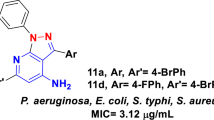Abstract
In the present investigation, a series of dihydrotriazine derivatives-bearing 5-aryloxypyrazole moieties were synthesized and their structures were confirmed by different spectral tools. The biological evaluation in vitro revealed that some of the target compounds exerted good antibacterial and antifungal activity in comparison with the reference drugs. Among these novel hybrids, compound 10d showed the most potent activity with minimum inhibitory concentration values (MIC) of 0.5 µg/mL against S. aureus 4220, MRSA 3506 and E. coli 1924 strain. The cytotoxic activity of the compounds 6d, 6m, 10d and 10g was assessed in MCF-7 and HeLa cells. Growth kinetics study showed significant inhibition of bacterial growth when treated with different conc. of 10d. In vitro enzyme study implied that compound 10d exerted its antibacterial activity through DHFR inhibition. Moreover, significant inhibition of biofilm formation was observed in bacterial cells treated with MIC conc. of 10d as visualized by SEM micrographs.
Graphic abstract
Twenty-nine target compounds were designed, synthesized and evaluated in terms of their antibacterial and antifungal activities.









Similar content being viewed by others
References
Pasero C, D’Agostino I, De Luca F, Zamperini C, Deodato D, Truglio GI, Sannio F, Del Prete R, Ferraro T, Visaggio D, Mancini A, Guglielmi MB, Visca P, Docquier JD, Botta M (2018) Alkyl-guanidine compounds as potent broad-spectrum antibacterial agents: chemical library extension and biological characterization. J Med Chem 61:9162–9176. https://doi.org/10.1021/acs.jmedchem.8b00619
Overbye KM, Barrett JF (2005) Antibiotics: where did we go wrong? Drug Discov Today 10:45–52. https://doi.org/10.1016/S1359-6446(04)03285-4
Yin Z, Whittell LR, Wang Y, Jergic S, Liu M, Harry EJ, Dixon NE, Beck JL, Kelso MJ, Oakley AJ (2014) Discovery of lead compounds targeting the bacterial sliding clamp using a fragment-based approach. J Med Chem 57:2799–2806. https://doi.org/10.1021/jm500122r
Tanitame A, Oyamada Y, Ofuji K, Fujimoto M, Iwai N, Hiyama Y, Suzuki K, Ito H, Kawasaki M, Nagai K, Wachi M, Yamagishi J (2004) Synthesis and antibacterial activity of a novel series of potent DNA gyrase inhibitors. Pyrazole derivatives. J Med Chem 47:3693–3696. https://doi.org/10.1021/jm030394f
Güniz KS, Rollas S, Erdeniz H, Kiraz M, Cevdet EA, Vidin A (2000) Synthesis, characterization and pharmacological properties of some 4-arylhydrazono-2-pyrazoline-5-one derivatives obtained from heterocyclic amines. Eur J Med Chem 35:761–771. https://doi.org/10.1016/s0223-5234(00)90179-x
Penning TD, Talley JJ, Bertenshaw SR, Carter JS, Collins PW, Docter S, Graneto MJ, Lee LF, Malecha JW, Miyashiro JM, Rogers RS, Rogier DJ, Yu SS, Anderson GD, Burton EG, Cogburn JN, Gregory SA, Koboldt CM, Perkins WE, Seibert K, Veenhuizen AW, Zhang YY, Isakson PC (1997) Synthesis and biological evaluation of the 1,5-diarylpyrazole class of cyclooxygenase-2 inhibitors: identification of 4-[5-(4-methylphenyl)-3- (trifluoromethyl)-1H-pyrazol-1-yl]benzenesulfonamide (SC-58635, Celecoxib). J Med Chem 40:1347–1365. https://doi.org/10.1021/jm960803q
Sridhar R, Perumal PT, Etti S, Shanmugam G, Ponnuswamy MN, Prabavathy VR, Mathivanan N (2004) Design, synthesis and anti-microbial activity of 1H-pyrazole carboxylates. Bioorg Med Chem Lett 14:6035–6040. https://doi.org/10.1016/j.bmcl.2004.09.066
Comber RN, Gray RJ, Secrist JA (1992) Acyclic analogues of pyrazofurin: syntheses and antiviral evaluation. Carbohydr Res 216:441–452. https://doi.org/10.1016/0008-6215(92)84179-v
Kompis IM, Islam K, Then RL (2005) DNA and RNA synthesis: antifolates. Chem Rev 105:593–620. https://doi.org/10.1021/cr0301144
Wright DL, Anderson AC (2011) Antifolate agents: a patent review (2006–2010). Expert Opin Ther Pat 21:1293–1308. https://doi.org/10.1517/13543776.2011.587804
Hawser S, Lociuro S, Islam K (2006) Dihydrofolate reductase inhibitors as anti-bacterial agents. Biochem Pharmacol 71:941–948. https://doi.org/10.1016/j.bcp.2005.10.052
Zheng CJ, Song MX, Sun LP, Wu Y, Hong L, Piao HR (2012) Synthesis and biological evaluation of 5-aryloxypyrazole derivatives bearing a rhodanine-3-aromatic acid as potential antimicrobial agents. Bioorg Med Chem Lett 22:7024–7028. https://doi.org/10.1016/j.bmcl.2012.09.107
Xu LL, Zheng CJ, Sun LP, Miao J, Piao HR (2012) Synthesis of novel 1,3-diaryl pyrazole derivatives bearing rhodanine-3-fatty acid moieties as potential antibacterial agents. Eur J Med Chem 48:174–178. https://doi.org/10.1016/j.ejmech.2011.12.011
Zhang TY, Zheng CJ, Wu J, Sun LP, Piao HR (2019) Synthesis of novel dihydrotriazine derivatives bearing 1,3-diaryl pyrazole moieties as potential antibacterial agents. Bioorg Med Chem Lett 29:1079–1084. https://doi.org/10.1016/j.bmcl.2019.02.033
Bai XQ, Chen Y, Liu Z, Zhang LH, Zhang TY, Feng B (2019) Synthesis, antimicrobial activities, and molecular docking studies of dihydrotriazine derivatives bearing a quinoline moiety. Chem Biodivers 16:e1900056. https://doi.org/10.1002/cbdv.201900056
Fang XF, Li D, Tangadanchu VKR, Gopala L, Gao WW, Zhou CH (2017) Novel potentially antifungal hybrids of 5-flucytosine and fluconazole: design, synthesis and bioactive evaluation. Bioorg Med Chem Lett 27:4964–4969. https://doi.org/10.1016/j.bmcl.2017.10.020
Gao WW, Rasheed S, Tangadanchu VKR, Sun Y, Peng XM, Cheng Y, Zhang FX, Lin JM, Zhou CH (2017) Design, synthesis and biological evaluation of amino organophosphorus imidazoles as a new type of potential antimicrobial agents. Sci China Chem 60:769–785. https://doi.org/10.1007/s11426-016-9009-6
Zapotoczna M, O’Neill E, O’Gara JP (2016) Untangling the diverse and redundant mechanisms of Staphylococcus aureus biofilm formation. PLoS Pathog 12:e1005671. https://doi.org/10.1371/journal.ppat.1005671
Soto SM (2013) Role of efflux pumps in the antibiotic resistance of bacteria embedded in a biofilm. Virulence 4:223–229. https://doi.org/10.4161/viru.23724
Lam T, Hilgers MT, Cunningham ML, Kwan BP, Nelson KJ (2014) Structure-based design of new dihydrofolate reductase antibacterial agents: 7-(benzimidazol-1-yl)-2,4-diaminoquinazolines. J Med Chem 57:651–668. https://doi.org/10.1021/jm401204g
Oefner C, Bandera M, Haldimann A, Laue H, Schulz H (2009) Increased hydrophobic interactions of iclaprim with Staphylococcus aureus dihydrofolate reductase are responsible for the increase in affinity and antibacterial activity. J Antimicrob Chemother 63:687–698. https://doi.org/10.1093/jac/dkp024
Acknowledgements
This work was supported by the National Natural Science Foundation of China (No. 81773692); the Science and Technology Department of Jilin Province (No. 20180311016YY), the Department of Education of Jilin Province (No. JJKH20191070KJ); the Health Department of Jilin Province (No. 2018ZC034); and the Doctoral Foundation of Jilin Medical University (No. JYBS2018007).
Author information
Authors and Affiliations
Corresponding authors
Ethics declarations
Conflict of interest
The authors state no conflict of interest.
Additional information
Publisher's Note
Springer Nature remains neutral with regard to jurisdictional claims in published maps and institutional affiliations.
Electronic supplementary material
Below is the link to the electronic supplementary material.
Rights and permissions
About this article
Cite this article
Zhang, TY., Li, CS., Cui, MY. et al. Design, synthesis and evaluation of dihydrotriazine derivatives-bearing 5-aryloxypyrazole moieties as antibacterial agents. Mol Divers 25, 861–876 (2021). https://doi.org/10.1007/s11030-020-10071-9
Received:
Accepted:
Published:
Issue Date:
DOI: https://doi.org/10.1007/s11030-020-10071-9




